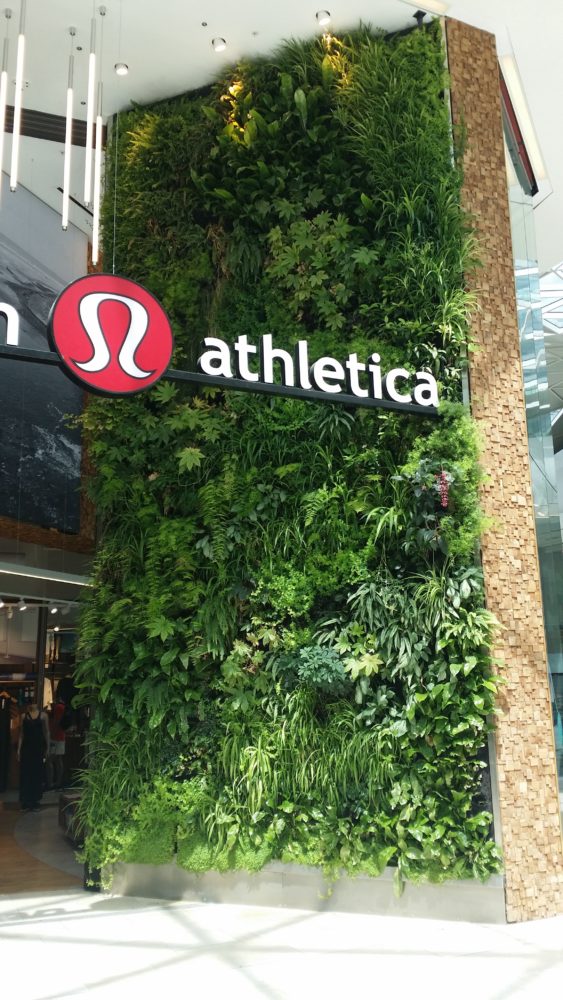
Our expansive range of clients includes many insightful retailers. Insightful you may ask, why? In brief consumers are likely to buy more merchandise in stores with natural vegetation. To meet proven data, Scotscape’s services are on hand to support retailers with the integration of vegetation to capitalise on this. Our Living Walls can be specified for interior or exterior use, our special projects team can assist with pot plant combinations, or broader external landscaping for shopping centres and retail parks, or for a bespoke application our in-house team can design unique systems to meet our client’s brief, as seen at the Asics stores in Brussels Amsterdam and Oxford Street.
Terrapin Bright Green – the globally acclaimed US Environmental Consultant – describes why in their document ‘The Economics of Biophilia’ extracts of which are shown here.
Biophilia, the innate human attraction to nature, is a concept that has been recognized for several decades by the scientific and design communities, and intuitively for hundreds of years by the population at large. Biophilic design has often been regarded as a luxury for property owners who want the best possible workplace for their employees, or who want to showcase their efforts to be more environmentally responsible. In reality, improving community well-being through biophilia can impact productivity costs and the bottom line.

There is evidence that consumers are likely to buy more merchandise in stores with strategically situated natural vegetation. It is not a coincidence that store and mall layouts are mapped to intentionally and meticulously guide shoppers through a maze of products surrounded by strategically placed plants, trees, and skylights; small yet powerful influences over consumers can lead retail stakeholders to enjoy greater profits if biophilic greening practices are employed (Joye, 2010). Builders have capitalized on our innate affinity for the savanna-like environments of our early Homo sapien ancestors—with clustered trees, semi-open spaces, refuge from the sun, water features, multiple-view corridors, and high levels of visual access—and we see these increasingly in shopping malls across the country (Heerwagen, 1998).

In a consumer study of biophilic store designs, participants were shown photographs of retail environments and asked to measure the visual quality, place perception (judgment of products, product value, and merchant responsiveness), patronage behaviour (frequency and duration of shopping actions), and price perceptions in three different types of shopping environments: green streets with high vegetation content, enclosed sidewalks with scattered greenery, and streets with no visible vegetation. The results were clear: well-tended streets with large trees received the highest preference ratings even though plants obscured some products and building facades (Wolf, 2005). Images of tidy business districts with no trees received the lowest scores. The place perception results revealed that consumers associated trees as attractive and appealing additions to their shopping experience and ranked these streets as well-maintained, friendlier, and more worthy of their dollars than the barren or enclosed sidewalk streets. Shoppers said they would stay longer once in a shop and would visit the business district more frequently—an accurate reflection of spending habits— when vegetation was heavily prevalent. This same study reveals a compelling increase in the hedonic value of goods sold in greener areas versus retail locations that are devoid of nature. When shown images of greener retail settings, respondents indicated that an acceptable price to pay was 20% higher for an item in convenient shopping (i.e., a sandwich for lunch), 25% higher for general shopping (i.e., a new jacket or watch), and 15% more for specialty shopping (i.e., a gift for a family member) (Wolf, 2005). The addition of plant life into the realm of retail shopping appears to act as a stimulus that boosts the image perception and economic viability of stores.
Scotscape’s multi-disciplinary approach can help introduce vegetation where it is needed, to drive sales and bring the feel good factor to staff and customers alike.
For advice contact our friendly team at [email protected]

